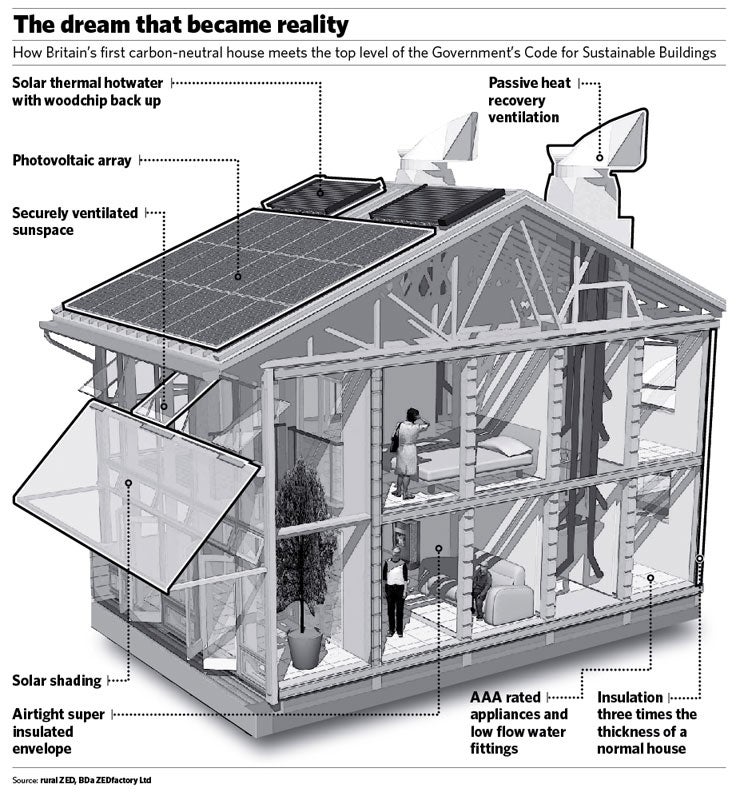On the market: the zero-carbon home with an affordable price

Your support helps us to tell the story
From reproductive rights to climate change to Big Tech, The Independent is on the ground when the story is developing. Whether it's investigating the financials of Elon Musk's pro-Trump PAC or producing our latest documentary, 'The A Word', which shines a light on the American women fighting for reproductive rights, we know how important it is to parse out the facts from the messaging.
At such a critical moment in US history, we need reporters on the ground. Your donation allows us to keep sending journalists to speak to both sides of the story.
The Independent is trusted by Americans across the entire political spectrum. And unlike many other quality news outlets, we choose not to lock Americans out of our reporting and analysis with paywalls. We believe quality journalism should be available to everyone, paid for by those who can afford it.
Your support makes all the difference.Once it was a dream; then it was an experiment; and now, from today, the zero-carbon house is a reality.
You can pick up the phone and order one, and in three months you can be living your life without contributing anything from your domestic surroundings to Britain's greenhouse gas emissions, the manufacturers say. They're a consortium of green building companies called ruralZED, and they say the house they unveiled at the EcoBuild Exhibition at Earl's Court in London yesterday is the first truly affordable carbon-neutral home.
It meets the top level – Code 6 – of the Government's Code for Sustainable Buildings, which all new housing will have to meet from 2016. Although connected to the National Grid, the ruralZED house is designed to go through the whole year without drawing on the grid for any power whatsoever.
This is because its super-insulation (three times as much as a normal house) means that, other than in exceptional circumstances, it will not need heating in January, or air conditioning in August. One small radiator and a tiny cooling system are optional extras for days of extreme weather.
The electricity that it will use, to power its state-of-the-art energy saving domestic appliances, is generated by the house itself from an array of solar panels on the roof. If you are in a suitable site for a roof wind turbine, you may be able to generate enough surplus energy, say the manufacturers, to run an electric car for 10,000 miles.
Water heating will be from other roof panels, backed up in winter by a biomass boiler (fired by wood chips) which can serve half-a-dozen houses at a time. The house itself is based around a very strong timber frame, supplied as a flat-pack kit, "a bit like a sofa from Ikea", according to Bill Dunster, the director of ZEDfactory, the architectural firm behind the project.
The cost for a three-bedroom version, including setting up, which will take about three weeks – and ruralZED will erect it for you – will be about £150,000. Note that this is not the finished house price. It does not include the price of the land, or installation of the surrounding infrastructure.
But to get an idea of comparative costs, the build price of a three-bedroom home put up according to current building regulations – which will soon be out of date – is about £100,000. On the other hand, the build price of the only other Code 6, zero-carbon home so far designed in Britain, the Lighthouse, created by the building materials firm Kingspan Offsite, is about £180,000, Kingspan say – and you have to erect it yourself.
This cost differential makes the ruralZED house a practical proposition, especially for housing associations, the consortium says. The first six homes are being built, 24 more are in the planning stage, and the finance director, Anthony Dickinson, said he expects to sell "thousands" in two to three years – "mainly to self-builders and local authorities, but looking to market them to commercial house builders".
The key to the house is that it has high levels of "thermal mass" – the ability of a material to absorb and release heat slowly. This is provided by the extremely thick insulation around the walls. Further temperature control is provided by a heat exchanger in the ventilation system, which does not require any power.
Mr Dunster said the house is is "the most serious contender in the race to beat the effects of residential carbon emissions. And remember, emissions from the domestic sector in Britain are 30 per cent of the total."
Mr Dunster, who was responsible for BedZED (Beddington Zero Energy Development), the low-carbon community in south London, said: "Until now, prototypes of other house designs have lacked the commercial and financial viability to make them serious alternatives to traditional housing and building techniques."
Join our commenting forum
Join thought-provoking conversations, follow other Independent readers and see their replies
Comments